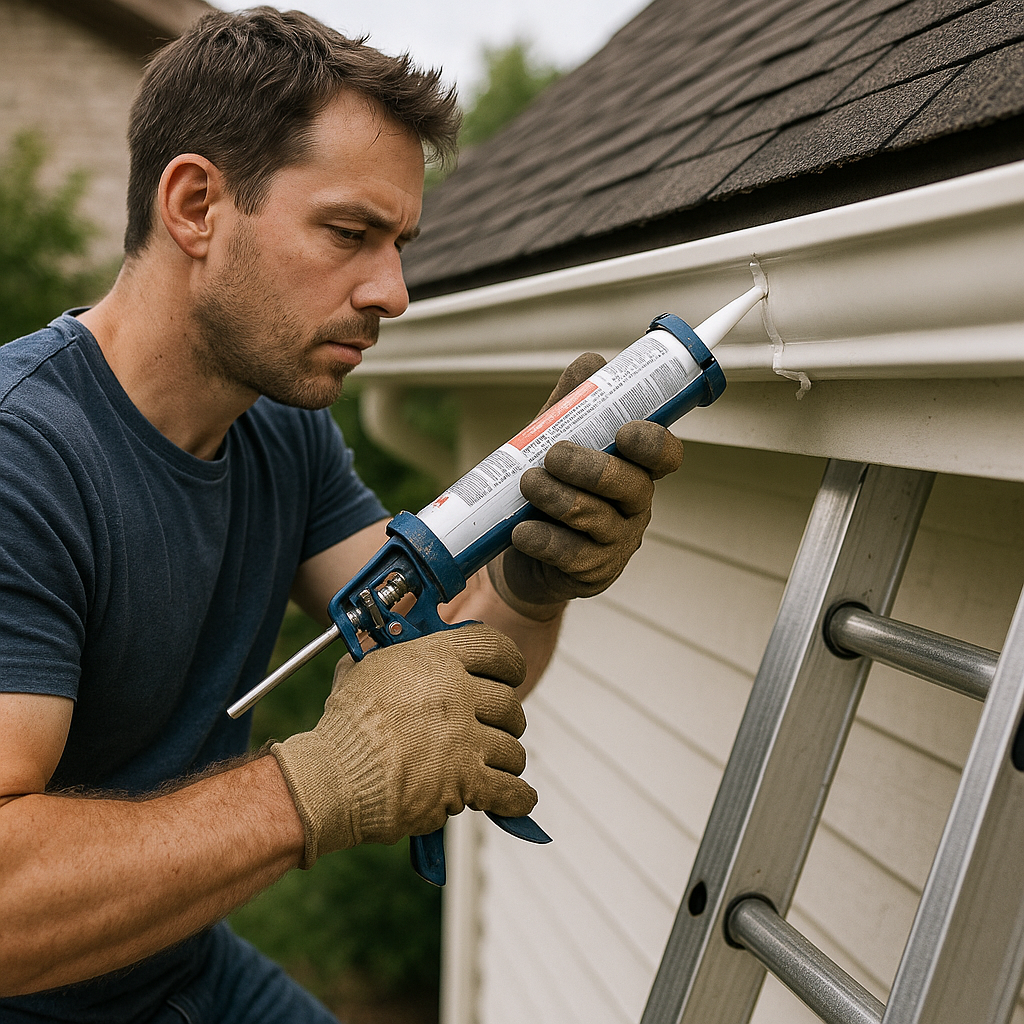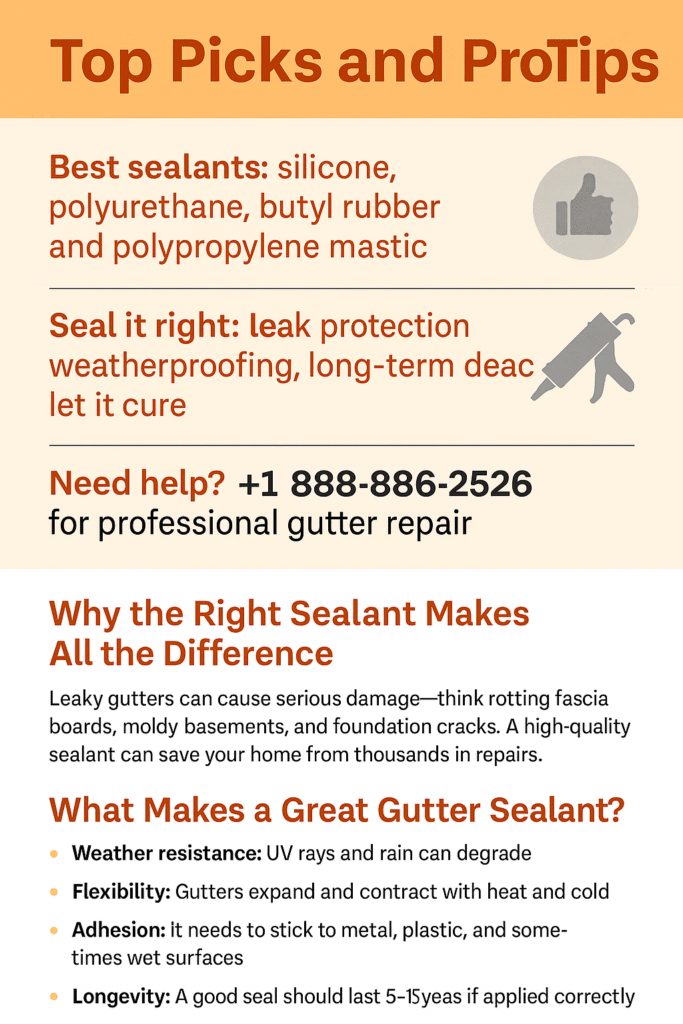TL;DR – Top Picks and Pro Tips
- Best sealants: silicone, polyurethane, butyl rubber, and polypropylene mastic
- Top benefits: leak protection, weatherproofing, long-term durability
- Seal it right: clean surface, apply sealant, smooth the bead, let it cure
- Need help? Call +1 888‑886‑2526 for professional gutter repair

Why the Right Sealant Makes All the Difference
Leaky gutters can cause serious damage—think rotting fascia boards, moldy basements, and foundation cracks. A high-quality sealant can save your home from thousands in repairs.
As a gutter pro, I’ve seen everything from slap-on duct tape jobs to caulks that peel off within weeks. Picking the best sealant for gutter repairs isn’t just about plugging a hole—it’s about making it stay sealed through storms, UV rays, and seasonal changes.
What Makes a Great Gutter Sealant?
Here’s what we look for in a top-tier gutter sealant:
- Weather resistance: UV rays and rain can degrade cheaper products fast.
- Flexibility: Gutters expand and contract with heat and cold.
- Adhesion: It needs to stick to metal, plastic, and sometimes wet surfaces.
- Longevity: A good seal should last 5–15 years if applied correctly.
1. 100% Silicone Sealants – Flexible & Waterproof
This is the go-to for most pros. Silicone stays flexible in hot or cold temps and holds up in wet conditions.
Pros:
- Excellent water resistance
- Long-lasting (up to 20 years)
- Ideal for aluminum, vinyl, or galvanized gutters
Cons:
- Doesn’t paint well
- Needs a super-clean surface to bond
Pro Tip: Use clear silicone for hidden joints or white for visible seams.
2. Polyurethane (Urethane-Based) Sealants – Durable & Tough
These are next-level strong. Polyurethane forms a rubber-like bond that’s highly durable and paintable.
Pros:
- Excellent adhesion
- Stronger than silicone in many applications
- UV and moisture resistant
Cons:
- Longer cure time
- Messy to work with if you’re not careful
I like using polyurethane when working on older metal gutters that see a lot of movement.
3. Butyl Rubber Tape or Caulk – Quick Fix, Not a Forever Fix
Butyl is sticky and versatile. Great for temporary fixes or lining inside seams before adding more robust sealant.
Pros:
- Easy to apply (especially in tape form)
- Works in cold and damp conditions
Cons:
- Not ideal for long-term sealing
- Can degrade faster in direct sun
This is what I call the “weekend warrior’s friend”—it’s easy, but don’t expect it to last forever.
4. Polypropylene Mastic Sealants – Thick & Reliable
This heavy-duty option is great for major patch jobs. It fills larger gaps and seals around brackets, holes, or seams that have warped over time.
Pros:
- Thick, paintable, and great for metal or wood
- Bonds well to rough surfaces
Cons:
- Takes longer to dry
- Can be messy—gloves are a must!
How to Apply Gutter Sealant Like a Pro
Even the best sealant will fail if it’s not applied right. Here’s how we do it in the field:
- Prep the surface: Remove debris, rust, or old sealant. Use a wire brush if needed.
- Dry the area: Some sealants work on damp surfaces, but a dry base is always better.
- Cut and apply the sealant: Use a caulking gun and apply an even bead directly into seams or cracks.
- Tool the bead: Use a gloved finger or caulking tool to smooth and press it into place.
- Let it cure: Follow the manufacturer’s cure time—this is usually 24–48 hours.
A Real-World Fix That Held Up for Years
One of our customers in North Carolina had a gutter system pulling apart at the seams—literally. We cleaned the joints, applied a silicone/polyurethane combo, and resealed the brackets. Three hurricane seasons later, it’s still bone-dry. That’s the power of using the right sealant the right way.
When to Call a Pro
If your gutters are leaking at multiple points, pulling away from the fascia, or rusted through—sealant alone won’t cut it. That’s where a professional repair or full replacement may be necessary.
Don’t want to mess with ladders and caulking guns?
Call our team at +1 888‑886‑2526 and we’ll handle it quickly and safely.

FAQs About Gutter Sealants
Can I just use Flex Seal or spray-on rubber?
Those work in a pinch, but they don’t offer the long-term strength or flexibility of silicone or polyurethane.
How long does gutter sealant last?
With proper prep and application, high-quality sealants can last 5–15 years.
Should I reseal gutters every year?
No need unless you spot leaks. Inspect twice a year and reseal only when cracks appear.
What temperature should I apply gutter sealant?
Most sealants work best between 40–85°F—avoid applying in freezing temps.
Final Thoughts – Seal it Once, Seal it Right
Whether you’re fixing a small drip or sealing up a leaky seam, choosing the best sealants for gutter repairs makes a huge difference. Go for long-lasting products, follow application steps carefully, and your gutters will be leak-free for years.
Still unsure what to use—or want it done right the first time?
Call +1 888‑886‑2526 for friendly, professional help with all your gutter sealing needs.